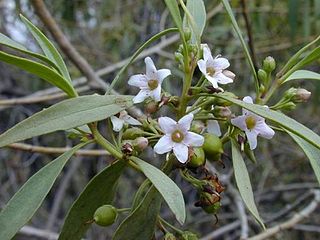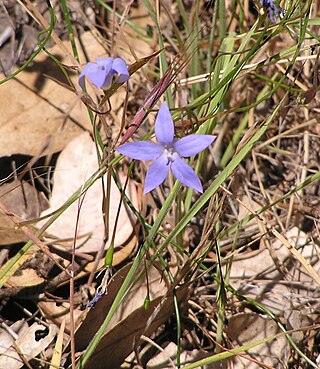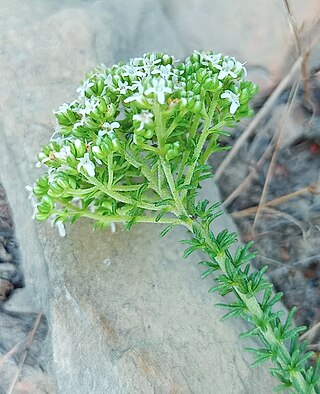
The Scrophulariaceae are a family of flowering plants, commonly known as the figwort family. The plants are annual and perennial herbs, as well as shrubs. Flowers have bilateral (zygomorphic) or rarely radial (actinomorphic) symmetry. The Scrophulariaceae have a cosmopolitan distribution, with the majority found in temperate areas, including tropical mountains. The family name is based on the name of the included genus Scrophularia L.

Johann Jacob Dillen Dillenius was a German botanist. He is known for his Hortus Elthamensis on the rare plants around Eltham, London, and for his Historia muscorum, a natural history of lower plants including mosses, liverworts, hornworts, lycopods, algae, lichens and fungi.

Plantaginaceae, the plantain family or veronica family, is a large, diverse family of flowering plants in the order Lamiales that includes common flowers such as snapdragon and foxglove. It is unrelated to the banana-like fruit also called "plantain". In older classifications, Plantaginaceae was the only family of the order Plantaginales, but numerous phylogenetic studies, summarized by the Angiosperm Phylogeny Group, have demonstrated that this taxon should be included within Lamiales.

Phrymaceae, also known as the lopseed family, is a small family of flowering plants in the order Lamiales. It has a nearly cosmopolitan distribution, but is concentrated in two centers of diversity, one in Australia, the other in western North America. Members of this family occur in diverse habitats, including deserts, river banks and mountains.

Myoporum is a genus of flowering plants in the figwort family, Scrophulariaceae. There are 30 species in the genus, eighteen of which are endemic to Australia although others are endemic to Pacific Islands, including New Zealand, and one is endemic to two Indian Ocean islands. They are shrubs or small trees with leaves that are arranged alternately and have white, occasionally pink flowers and a fruit that is a drupe.

Wahlenbergia is a genus of around 260 species of flowering plants in the family Campanulaceae. Plants in this genus are perennial or annual herbs with simple leaves and blue to purple bell-shaped flowers, usually with five petals lobes. Species of Wahlenbergia are native to environments on all continents except North America, and on some isolated islands, but the greatest diversity occurs in the Southern Hemisphere.
Selago lepida is a species of plant in the family Scrophulariaceae. It is endemic to Namibia. Its natural habitats are subtropical or tropical dry shrubland and rocky areas. It is threatened by habitat loss.
Selago nachtigalii is a species of plant in the family Scrophulariaceae. It is endemic to Namibia. Its natural habitat is cold desert.

Trichocladus is a genus of plant in family Hamamelidaceae, consisting of shrubs or small trees. The distinguishing features of the genus Trichocladus are as follows:

Dendroconche scandens, synonym Microsorum scandens, commonly called fragrant fern, is a species of fern within the family Polypodiaceae. This species is native to parts of New Zealand and Australia, as well as some offshore islands. It has been introduced to South Africa and Zimbabwe. An example occurrence in New Zealand's North Island is in the Hamilton Ecological District where it is associated with a number of other ferns including Icarus filiforme and Lomaria discolor. In general, it is found in lowland and coastal forested regions.

Selago ramosissima is a species of plant in the family Scrophulariaceae. It is endemic to the Western Cape, South Africa.
Selago aspera is a species of plant in the family Scrophulariaceae. It is endemic to the southern Cape Provinces, South Africa.
Selago thomii is a species of plant in the family Scrophulariaceae. It is endemic to the Western Cape, South Africa.

Selago triquetra is a species of plant in the family Scrophulariaceae. It is endemic to Western Cape Province, South Africa.
Selago fruticosa is a species of plant in the family Scrophulariaceae. It is endemic to South Africa.
Selago eckloniana is a species of plant in the family Scrophulariaceae. It is endemic to the Western Cape, South Africa.
Selago luxurians is a species of plant in the family Scrophulariaceae. It is indigenous to the southern Cape region of South Africa. It occurs from Riversdale in the west, as far east as Port Elizabeth, and as far inland as the Swartberg mountains.
Selago glomerata is a species of plant in the family Scrophulariaceae. It is indigenous to the southern Cape coastal region of South Africa. It occurs from George in the west, as far east as Algoa bay, and as far inland as the Outeniqua, Kouga and Baviaanskloof mountains. This species has white flowers, that often fade to a pale purple colour when dry.

Selago dolosa is a species of plant in the family Scrophulariaceae. It is endemic to South Africa.

Selago corymbosa is a species of plant in the family Scrophulariaceae. It is endemic to South Africa.












